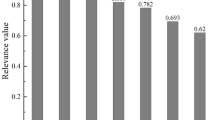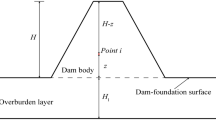Abstract
In the process of urban underground space development, it is necessary to predict the ground settlement around the deep foundation pit to protect the surrounding environment. At present, there are few studies on the subsidence of sand and pebble strata. Furthermore, in some engineering sites with multifactor coupling effects, the theoretical calculation is large and the accuracy is low. Consequently, this study introduces the measured data analysis method and focuses on the comparative analysis of settlement prediction models based on grey theory and the back propagation (BP) neural network theory. The surface subsidence data around the deep foundation pit at the metro station in Chengdu, China (which is mainly composed of sand and pebble strata) are used to formulate a prediction and propose an optimized grey prediction model of land subsidence and a one-dimensional double-hidden-layer BP neural network subsidence prediction model. The results show that the prediction results of the two models are accurate and the final prediction results are of certain engineering reference value.







Similar content being viewed by others
Change history
09 April 2022
This article has been retracted. Please see the Retraction Notice for more detail: https://doi.org/10.1007/s12517-022-10082-w
28 September 2021
An Editorial Expression of Concern to this paper has been published: https://doi.org/10.1007/s12517-021-08472-7
References
Banimahd M, Yasrobi SS, Woodward PK (2005) Artificial neural network for stress–strain behavior of sandy soils: Knowledge based verification. Comput Geotech 32(5):377–386
Benbouhenni H, Boudjema Z, Belaidi A (2020) Power control of DFIG in WECS using DPC and NDPC-NPWM methods. Math Model Eng Problem 7(2):223–236
Berrezzek F, Khelil K, Bouadjila T (2019) Efficient wind speed forecasting using discrete wavelet transform and artificial neural networks. Revue d'Intelligence Artificielle 33(6):447–452
Biot MA (1941) General theory of three-dimensional consolidation. J Appl Phys 12(2):155–164
Chen CX, Pei SP (2001) Research on groundwater exploitation-land subsidence model. Hydrogeol Eng Geol 2:5–8
Chouidira I, Khodja DE, Chakroune S (2019) Induction machine faults detection and localization by neural networks methods. Revue d'Intelligence Artificielle 33(6):427–434
Dai WZ, Xiong W, Yang AP (2010) Grey modeling based on cot (xα) transformation and background value optimization. J Zhejiang Univ Eng Sci 44(7):1368–1372
Gao MZ, Zhang ZL, Qiu ZQ, Xu C, Zhao J (2018) The mechanism of hysteretic ground settlement caused by shield tunneling in mixed-face conditions. Geomech. Geophys. Geo-Energy Geo-Resour 4(1):51–61
He C, Feng K, Fang Y, Jiang YC (2012) Surface settlement caused by twin-parallel shield tunnelling in sandy cobble strata. J Zhejiang Univ Sci A 13(11):858–869
Hu B, Zhao J, Wei H, Wei X, Guo X, Zhu H (2018) Research on gray GM (1,1) model optimization method.J. China & Foreign Highway 38(4):4–8
Jallal MA, Yassini AE, Chabaa S, Zeroual A, Ibnyaich S (2020) AI data driven approach-based endogenous inputs for global solar radiation forecasting.Ing. des Syst. d'Information 25(1):27–34
Jiang TC (2009) Forecasting sedimentation of constructions based on BP network. Environ Sci Inform Appl Technol 1:649–652
Krishna KVSSR, Prakash BB (2019) Intrusion detection system employing multi-level feed forward neural network along with firefly optimization (FMLF2N2). Ingénierie des Systèmes d’Information 24(2):139–145
Li, D.W., Chen, R.L. (2013). Application of BP neural network prediction model in subsidence prediction of high-speed railway. Bulletin of Surveying and Mapping, (S1), 192-194+206.
Li XG, Zhang TH (2016) Application of the GM (1, 1) gray prediction model in the road soft foundation settlement prediction. J Railway Sci Eng 13(1):63–68
Li XZ, Kong JM, Wang CH (2007) Comparative application of grey GM(1,1) residual correction model in landslide prediction. J Mt Sci 06:741–746
Li Z, Yang X, Huan CB, Deng ML (2009) Prediction and control on ground surface settlement during shield construction on sandy cobble stratum. Archit Technol 40(11):1021–1022
Li Z, Luo Z, Wang Q, Du J, Lu W, Ning D (2019a) A three-dimensional fluid-solid model, coupling high-rise building load and groundwater abstraction, for prediction of regional land subsidence. Hydrogeol J 27(4):1515–1526
Li Y, Shi DL, Bu FJ (2019b) Automatic recognition of rock images based on convolutional neural network and discrete cosine transform. Traitement du Signal 36(5):463–469
Luo ZJ, Huang XR (2009) Three-dimensional full coupling numerical simulation of groundwater exploitation and control of land-subsidence in region. Chinese J. Hydrodyn (Ser A) 24(5):566–574
Luo ZJ, Liu JB, Li L, Huo CS (2006) Numerical simulation based on the three dimensional full coupling model between deep foundation pit dewatering and land-subsidence. Chinese J. Hydrodyn (Ser. A) (4):479–485
Martin TH, Howard BD, Mark HB (2002) Neural network design. China Machine Press, Beijing, China
Mc Culloch WS, Pitts W (1943) A logical calculus of the ideas immanent in nervous activity. Bull Math Biophys 5(4):115–133
Pei JY, Shan P (2019) A micro-expression recognition algorithm for students in classroom learning based on convolutional neural network. Traitement du Signal 36(6):557–563
Peng T, Yang AY, Liang X, Yuan Q (2005) Prediction of soft ground settlement based on BP neural network-grey system united model. Rock Soil Mech 11:119–123
Reddy UJ, Reddy BRVR, Reddy BE (2019) Recognition of lung cancer using machine learning mechanisms with fuzzy neural networks. Traitement du Signal 36(1):87–91
Shi XQ, Xue YQ, Ye SJ, Wu JC, Zhang Y, Yu J (2007) Characterization of land subsidence induced by groundwater withdrawals in Su-Xi-Chang area, China. Environ Geol 52(1):27–40
Sidarta DE, Ghaboussi J (1998) Constitutive modeling of geomaterials from non-uniform material tests. Comput Geotech 22(1):53–71
Su CW, Ding KL, Zhou MD, Liu M (2015) Monitoring and forecasting model of metro surface subsidence based on cubic spline interpolation function. Bull Surv Map S1:160–162
Sun XH, Mo ZB, Li SY (2010) Application of non - isochronous grey model in settlement prediction of soft soil subgrade. J. China & Foreign Highway 30(05):60–62
Wajeed MA, Sreenivasulu V (2019) Image based tumor cells identification using convolutional neural network and auto encoders. Traitement du Signal 36(5):445–453
Wang FX (2006) Unequal interval grey forecast models based on the modificatory initial-value. J Chongqing Normal Univ (Natural Science) 23(3):42–44
Wang YW (2016) Numerical simulation of regional land subsidence in coastal area of north Jiangsu. Nanjing University, Nanjing
Yang JH, Kong DY (2018) Construction measuring and deformation analysis of foundation pit in deep silt soil layer under complicated environment. Instrumentation Mesure Métrologie 17(1):167–185
Yao B (2018) Subsidence prediction of coal gangue embankment based on BP artificial neural network. Central South University of Forestry and Technology, Hunan
Ye SJ, Xue YQ, Zhang Y, Li QF, Wang HM (2005) Study on the deformation characteristics of soil layers in regional land subsidence model of Shanghai. Yantu Gongcheng Xuebao (Chin J Geotech Eng) 27(2):140–147
Yuan BQ, Cheng G, Zheng LG (2018) Basic principle of BP neural networks. Digital Commun World 08:28–29
Zhang Y, Xue YQ (2002) Present situation and prospect on the mathematical model of land subsidence due to pumping. Chin J Geol Hazard Control 13(2):1–6
Zhang Y, Yang J, Wei LH (2018) Prediction of Hedong airport subsidence based on improved unequal time-interval gray system model. Geotech Investig Surv 46(10):42–46
Zhu YJ, Han WX (2017) Improved non-equidistance gray model and its application in settlement prediction. Value Eng 36(3):136–137
Funding
The present work was carried out with the support of China Communications Road Construction Technology R&D Project (ZJLY-2018-44).
Author information
Authors and Affiliations
Corresponding author
Additional information
This article is part of the Topical Collection on Big Data and Intelligent Computing Techniques in Geosciences
This article has been retracted. Please see the retraction notice for more detail:https://doi.org/10.1007/s12517-022-10082-w
Appendix
Appendix
About this article
Cite this article
Lv, Y., Liu, T., Ma, J. et al. RETRACTED ARTICLE: Study on settlement prediction model of deep foundation pit in sand and pebble strata based on grey theory and BP neural network. Arab J Geosci 13, 1238 (2020). https://doi.org/10.1007/s12517-020-06232-7
Received:
Accepted:
Published:
DOI: https://doi.org/10.1007/s12517-020-06232-7




